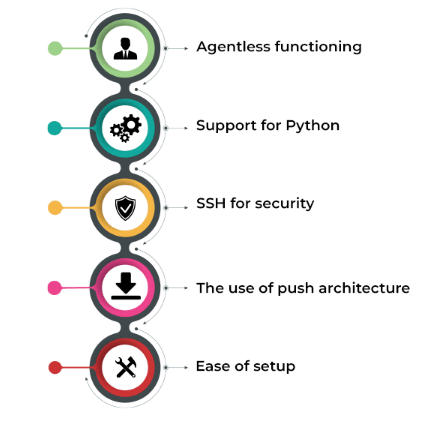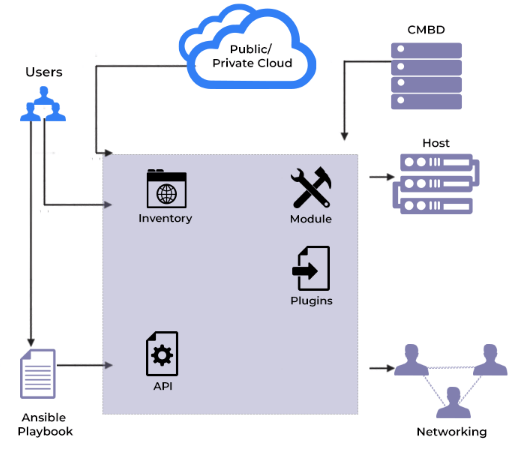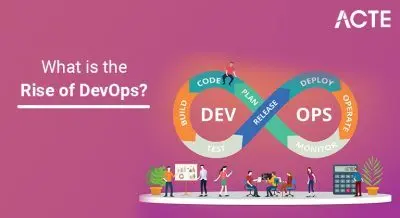
- Introduction to Ansible
- Why Ansible is Important in DevOps
- Key Features of Ansible
- How Ansible Works
- Ansible vs Other Configuration Management Tools
- Advantages of Using Ansible
- Common Use Cases of Ansible
- Conclusion
Introduction to Ansible
Ansible in DevOps is a powerful open-source automation tool widely used in DevOps for automating IT tasks such as configuration management, application deployment, and infrastructure orchestration. Developed by Michael DeHaan in 2012, Ansible has become a popular choice for DevOps teams due to its simplicity, ease of use, and agentless architecture. Unlike many other configuration management tools, Ansible does not require any agents or additional software to be installed on the managed systems. Instead, it uses SSH (Secure Shell) for communication, making it lightweight, efficient, and easy to set up. Ansible, often featured in DevOps Training, allows users to describe the desired state of their systems using a simple, human-readable language known as YAML. This declarative approach simplifies the management of complex, multi-tier IT systems by enabling users to automate tasks such as configuration, application deployment, and system updates. While Ansible was initially designed to manage Linux systems, it also supports Windows and macOS, making it versatile for various environments. Its ease of use and powerful capabilities have made Ansible a go-to tool for automating and managing infrastructure in modern DevOps workflows.
Are You Interested in Learning More About DevOps? Sign Up For Our DevOps Online Course Today!
Why Ansible is Important in DevOps
Ansible is an essential tool in DevOps environments because it automates configuring and managing servers, applications, and infrastructure, key components of the software development lifecycle. Here’s why it is crucial for DevOps:
- Simplifies Automation: Ansible allows you to automate complex workflows, reducing the manual effort required for configuration, deployment, and maintenance tasks.
- Consistent Infrastructure: Ansible ensures that systems are configured the same way every time, eliminating configuration drift and ensuring consistency across environments a distinction often discussed in Agile vs DevOps comparisons.
- Faster Deployment: Automation speeds up the software delivery pipeline, enabling Continuous Integration/Continuous Delivery(CI/CD) practices.
- Collaboration: Ansible facilitates collaboration between development, operations, and other teams, as infrastructure and configuration are defined as code.
- Scalability: Ansible can easily scale from managing a few systems to thousands, making it suitable for small environments as well as large, enterprise-level infrastructures.
- Agentless Architecture: Ansible’s agentless approach simplifies management by eliminating the need to install and maintain agents on target systems, reducing overhead and streamlining setup.
- Agentless Architecture: Ansible does not require agents to be installed on the managed machines. Instead, it communicates via SSH, making it easier to set up and manage.
- Declarative Language: Ansible uses YAML (Yet Another Markup Language) to define tasks in configuration files called Playbooks, which makes it easy to read and write.
- Idempotency: Ansible ensures that if a task is run multiple times, it will only make changes if necessary. This prevents the same task from being executed repeatedly, ensuring efficiency.
- Extensibility: Ansible supports custom modules and plugins, allowing you to extend its functionality to suit your specific needs, a skill often relevant to a DevOps Engineer Salary, Roles & Responsibilities .
- Multi-platform Support: Ansible supports multiple platforms, including Linux, Windows, macOS, and cloud platforms like AWS, Azure, and GCP, making it versatile for various environments.
- Built-in Modules: Ansible provides hundreds of pre-built modules for tasks like file management, package installation, system service management, and more.
- Community Support: Ansible has a large and active community that continuously contributes to its development, offering resources, tutorials, and reusable content.
- Simplified Learning Curve: With its straightforward, human-readable syntax and lack of required agents, Ansible is easy to learn and implement, even for beginners.
- Language: Ansible uses a declarative language written in YAML, which is easy to read and write. In contrast, Puppet uses its own Puppet DSL, which can be more complex, while Chef relies on imperative Ruby scripts, requiring more programming knowledge.
- Agent-based vs. Agentless: Ansible is agentless, meaning it communicates via SSH, simplifying setup. Puppet, Chef, and SaltStack require agents to be installed on the managed nodes, adding complexity to the setup process.
- Ease of Use: Ansible is known for its easy-to-use YAML syntax, while Puppet, Chef, and SaltStack are moderately more complex due to their domain-specific languages and programming requirements.
- Idempotency: All four tools (Ansible, Puppet, Chef, SaltStack) ensure idempotency, meaning they only apply changes when necessary, preventing redundant operations and ensuring efficiency an important concept when comparing Ansible Vs Kubernetes.
- Extensibility: Ansible offers high extensibility through custom modules, and Puppet, Chef, and SaltStack also allow customization with modules, recipes, or custom states.
- Community Support: Ansible has a large and active community, providing extensive resources. Puppet, Chef, and SaltStack also have large communities, with SaltStack’s community rapidly growing.
- Overall: Ansible stands out for its simplicity, agentless setup, and high extensibility, making it a great choice for automating and managing infrastructure with minimal complexity.
- Simplicity and Readability: Ansible’s playbooks are written in YAML, which is easy to read and write. Even users without extensive programming experience can get started with Ansible.
- Agentless: Unlike other tools that require agents to be installed on every managed node, Ansible communicates over SSH or WinRM, simplifying management and reducing overhead.
- Scalability: Ansible can manage both small-scale environments as well as large, complex infrastructures, making it suitable for a wide range of use cases—a flexibility often discussed in the context of Docker vs Kubernetes.
- Ease of Integration: Ansible integrates well with other DevOps tools, such as Jenkins for CI/CD, Docker for container management, and Kubernetes for orchestration.
- Strong Community Support: Ansible has a large, active community that continuously develops new modules and provides extensive documentation and support.
- Cross-platform: Ansible works with a variety of operating systems and cloud providers, allowing you to manage diverse environments from a single platform.

Key Features of Ansible
Ansible has several powerful features that make it a preferred choice for automation in DevOps workflows. Some key features include:
To Explore DevOps in Depth, Check Out Our Comprehensive DevOps Online Course To Gain Insights From Our Experts!
How Ansible Works
Ansible operates using a simple client-server model to automate infrastructure management. At the core of this model is the Ansible Controller, which is the system where Ansible is installed and from where tasks are executed. Tasks and configurations are defined in Playbooks, which are written in YAML (Yet Another Markup Language). Playbooks, commonly covered in DevOps Training, describe the desired state of the infrastructure and consist of plays that map hosts to specific tasks. Ansible communicates with Managed Nodes (which are the systems or servers being configured) via SSH (for Linux systems) or WinRM (for Windows systems), eliminating the need to install any agent software on the nodes.

This agentless architecture simplifies setup and management. Ansible’s Inventory Files list the groups of hosts or machines to be managed, and these can either be static or dynamically generated. The typical workflow begins when the Ansible Controller sends a request to the Managed Nodes. Ansible then gathers system information from the nodes and compares it with the desired configuration specified in the Playbooks. It applies only the necessary changes, ensuring that each node is brought into the desired state. Leveraging idempotency, Ansible ensures that tasks are only executed when required, preventing unnecessary changes and promoting efficiency and consistency across environments.
Ansible vs Other Configuration Management Tools
Gain Your Master’s Certification in DevOps by Enrolling in Our DevOps Masters Course.
Advantages of Using Ansible
Common Use Cases of Ansible
Ansible is a highly versatile tool that plays a crucial role in various use cases within DevOps pipelines. One of its primary applications is configuration management, where it automates the consistent configuration of systems, ensuring that servers and applications are set up correctly across different environments. Ansible is also widely used for application deployment, enabling the deployment of applications across multiple servers while ensuring that all required dependencies are correctly installed and configured. Another key use case for Ansible is provisioning infrastructure, whether for physical hardware, virtual machines, or cloud environments. It simplifies the process of provisioning new systems, ensuring they are correctly configured from the outset an approach that can be applied when learning How To Install Jenkins on Ubuntu. In the realm of Continuous Integration/Continuous Delivery (CI/CD), Ansible automates the deployment pipeline, streamlining the process for fast, reliable, and repeatable application delivery. Ansible also plays a critical role in security automation, automating the enforcement of security policies and ensuring systems comply with required standards. Additionally, it excels at orchestrating multi-tier applications, managing complex, cloud-native applications across various environments and configurations. These capabilities make Ansible a powerful tool for automating a wide range of tasks in modern DevOps workflows, improving efficiency and consistency across the board.
Are You Preparing for DevOps Jobs? Check Out ACTE’s DevOps Interview Questions & Answer to Boost Your Preparation!
Conclusion
Ansible in DevOps has become one of the most popular automation tools due to its simplicity, ease of use, and powerful capabilities. It enables DevOps teams to automate tasks such as configuration management, application deployment, and infrastructure provisioning while ensuring consistency across systems and minimizing human errors. One of Ansible’s key advantages is its agentless architecture; it does not require any agents or additional software to be installed on the target systems. Instead, it communicates over SSH, making it lightweight and easy to deploy. Ansible’s declarative syntax, often emphasized in DevOps Training, allows users to define their infrastructure as code in a simple, human-readable language (YAML), which makes it easy to automate and manage even complex systems. Its flexibility means it can scale from managing a few servers to automating large-scale enterprise infrastructure, making it suitable for both small and large operations. Whether you are managing servers, deploying applications, or orchestrating infrastructure, mastering Ansible can streamline your workflows and significantly improve productivity. With its growing community and extensive documentation, Ansible is an excellent tool for anyone looking to get started with IT automation in DevOps.




